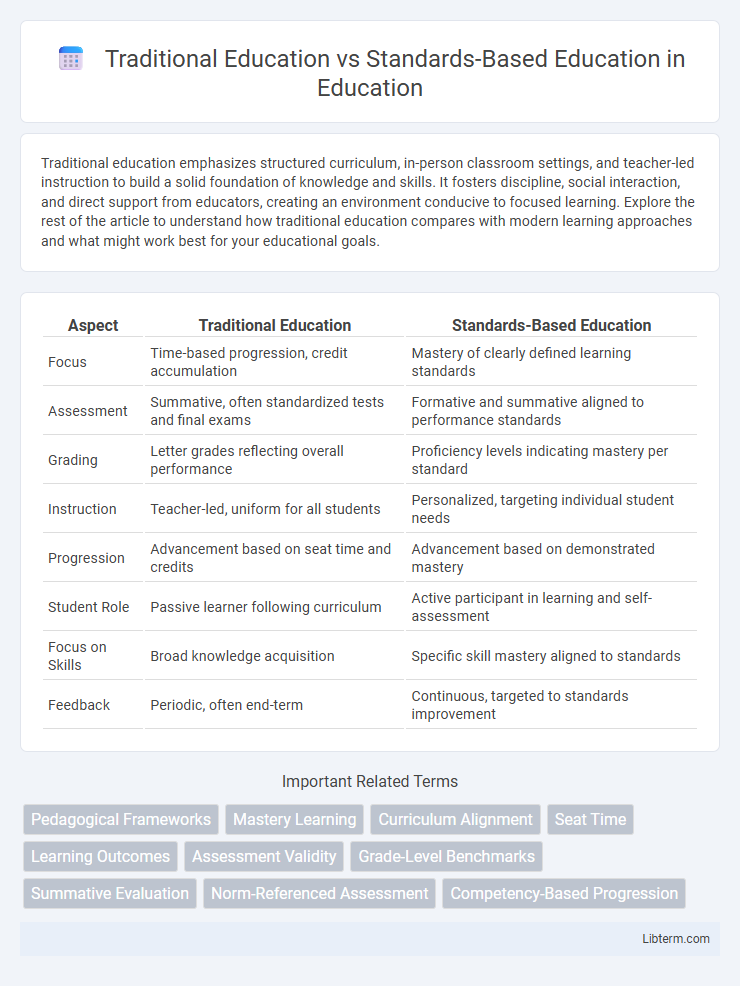Traditional education emphasizes structured curriculum, in-person classroom settings, and teacher-led instruction to build a solid foundation of knowledge and skills. It fosters discipline, social interaction, and direct support from educators, creating an environment conducive to focused learning. Explore the rest of the article to understand how traditional education compares with modern learning approaches and what might work best for your educational goals.
Table of Comparison
| Aspect | Traditional Education | Standards-Based Education |
|---|---|---|
| Focus | Time-based progression, credit accumulation | Mastery of clearly defined learning standards |
| Assessment | Summative, often standardized tests and final exams | Formative and summative aligned to performance standards |
| Grading | Letter grades reflecting overall performance | Proficiency levels indicating mastery per standard |
| Instruction | Teacher-led, uniform for all students | Personalized, targeting individual student needs |
| Progression | Advancement based on seat time and credits | Advancement based on demonstrated mastery |
| Student Role | Passive learner following curriculum | Active participant in learning and self-assessment |
| Focus on Skills | Broad knowledge acquisition | Specific skill mastery aligned to standards |
| Feedback | Periodic, often end-term | Continuous, targeted to standards improvement |
Overview of Traditional Education
Traditional education emphasizes teacher-centered instruction with a fixed curriculum focused on memorization, rote learning, and standardized testing. Students progress through grade levels based on age and seat time rather than demonstrated mastery of specific competencies or skills. This model prioritizes uniformity and compliance, often limiting personalized learning opportunities and real-time assessment of individual student performance.
Fundamentals of Standards-Based Education
Standards-Based Education centers on clear, measurable learning objectives aligned with academic standards to ensure students achieve specific competencies. It emphasizes mastery of defined skills over time spent in class, contrasting with Traditional Education's focus on seat time and grade-level progression. Assessment in standards-based models is continuous and formative, providing targeted feedback to support individual student growth toward achieving established standards.
Key Differences Between Both Approaches
Traditional education emphasizes teacher-led instruction, fixed curricula, and summative assessments to measure student performance, often focusing on rote memorization and standardized testing. Standards-based education centers on clear learning targets aligned with state or national standards, using formative assessments to track mastery and provide personalized feedback to support student growth. The key differences lie in the evaluation methods, curriculum flexibility, and the focus on skill mastery rather than time spent in class.
Curriculum Structure Comparison
Traditional education relies on a fixed curriculum organized by grade levels, emphasizing rote memorization and subject-specific knowledge accumulation. Standards-based education structures the curriculum around clear learning goals defined by state or national standards, enabling personalized pacing and mastery of specific skills. This approach aligns assessment with competencies, promoting deeper understanding rather than uniform content coverage.
Assessment Methods: Grades vs Mastery
Traditional education relies on grades as summative assessments, ranking students through percentage scores or letter grades to measure overall performance. Standards-based education emphasizes mastery by assessing specific skills and knowledge against predetermined criteria, providing detailed feedback on student progress. This shift from grades to mastery supports personalized learning and encourages continuous improvement rather than comparative evaluation.
Role of Teachers in Each System
In traditional education, teachers primarily serve as the authoritative source of knowledge, delivering content through lectures and assessments focused on memorization and rote learning. Standards-based education transforms the teacher's role into a facilitator and coach who guides students in mastering specific skills and competencies aligned with predefined standards. This approach requires teachers to continuously assess individual progress, personalize instruction, and use data-driven strategies to ensure all students achieve proficiency.
Impact on Student Learning Outcomes
Traditional education often relies on grade-based assessments and uniform curricula, which may not address individual student needs or learning paces effectively. Standards-based education emphasizes mastery of specific skills and knowledge aligned with state or national benchmarks, leading to clearer learning goals and more personalized feedback. Research indicates that standards-based approaches can improve student learning outcomes by promoting deeper understanding and consistent performance tracking.
Parental and Community Involvement
Parental and community involvement often differ significantly between traditional education and standards-based education, with standards-based models emphasizing collaborative engagement to improve student outcomes through shared accountability. In standards-based education, parents and communities receive clear, consistent performance data aligned with academic benchmarks, enabling targeted support and meaningful participation in student learning processes. Traditional education may rely more on periodic updates and less structured communication, which can limit ongoing parental insight and active community contribution.
Challenges and Criticisms of Each Model
Traditional education often faces criticism for its reliance on rote memorization and standardized testing, which can stifle creativity and fail to address diverse learning styles. Standards-based education, while promoting clear learning objectives and personalized progress tracking, encounters challenges in implementation consistency and may place excessive pressure on students and educators to meet rigid benchmarks. Both models struggle with balancing accountability and flexibility, impacting student engagement and equitable outcomes.
Future Trends in Educational Approaches
Future trends in educational approaches emphasize personalized learning through technology integration, moving beyond traditional education's one-size-fits-all model. Standards-based education continues evolving with data-driven assessments and competency mastery, enabling tailored instruction aligned with career and college readiness standards. Adaptive learning platforms and AI-powered analytics are transforming classrooms to support continuous feedback and skill development, preparing students for dynamic workforce demands.
Traditional Education Infographic

 libterm.com
libterm.com